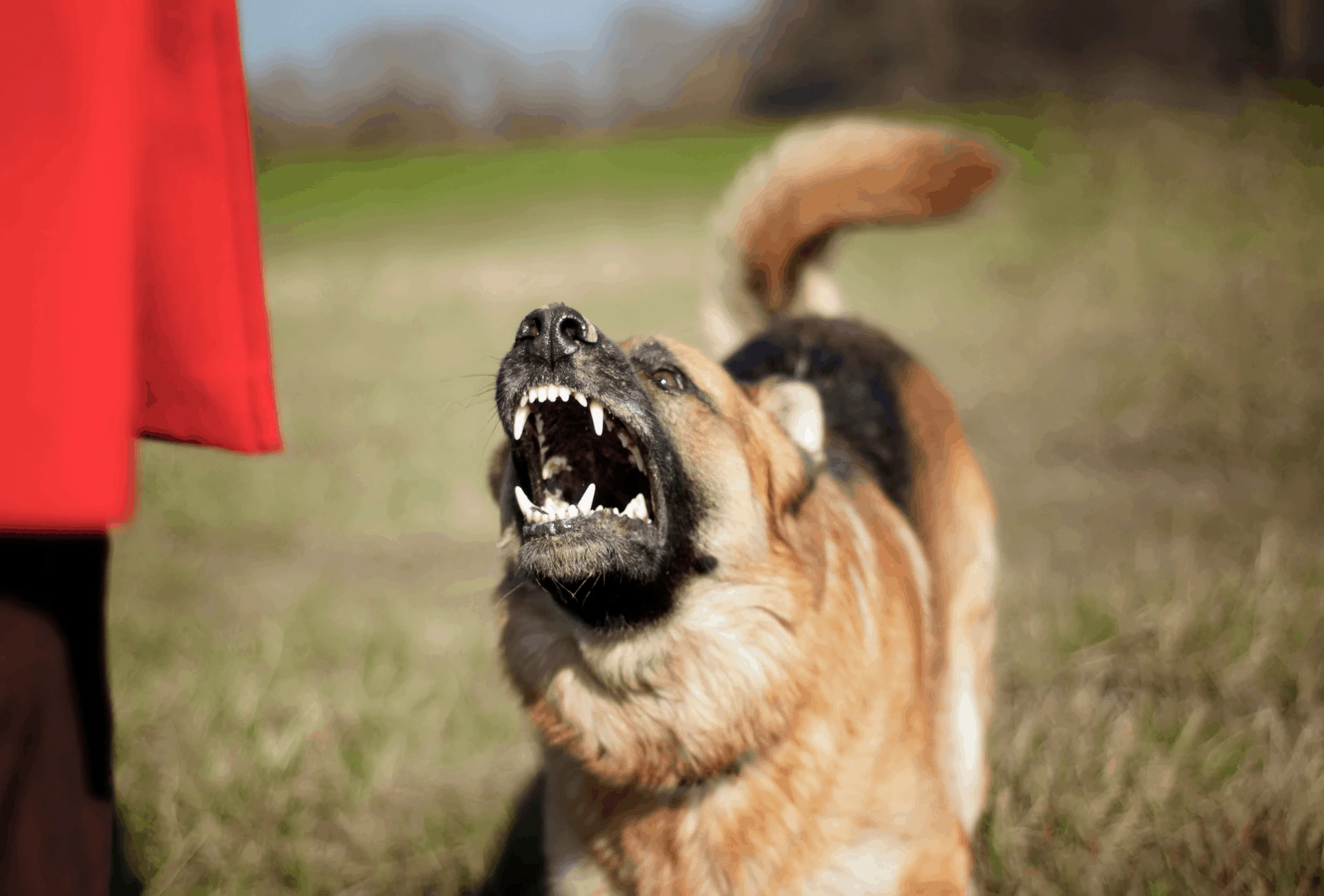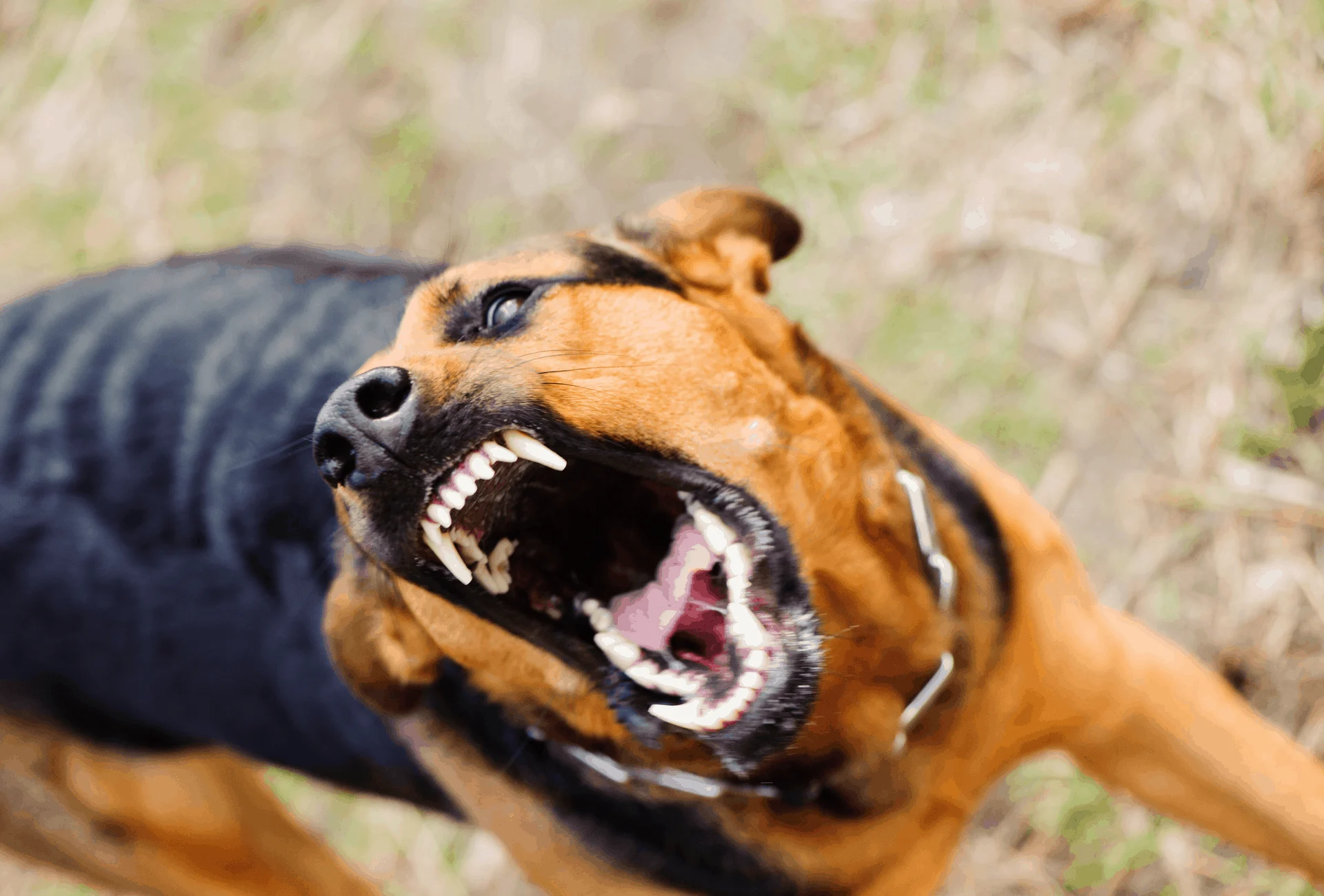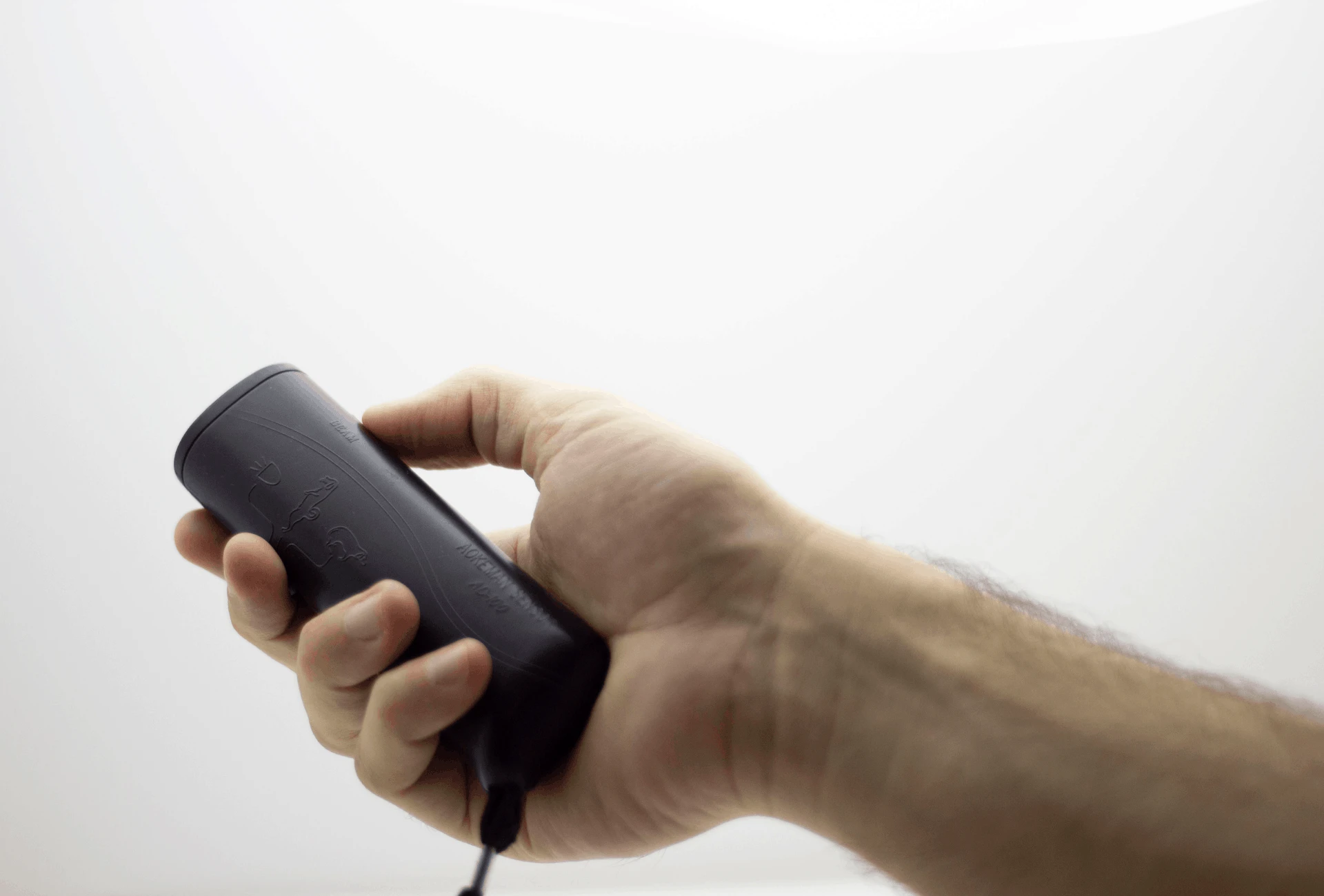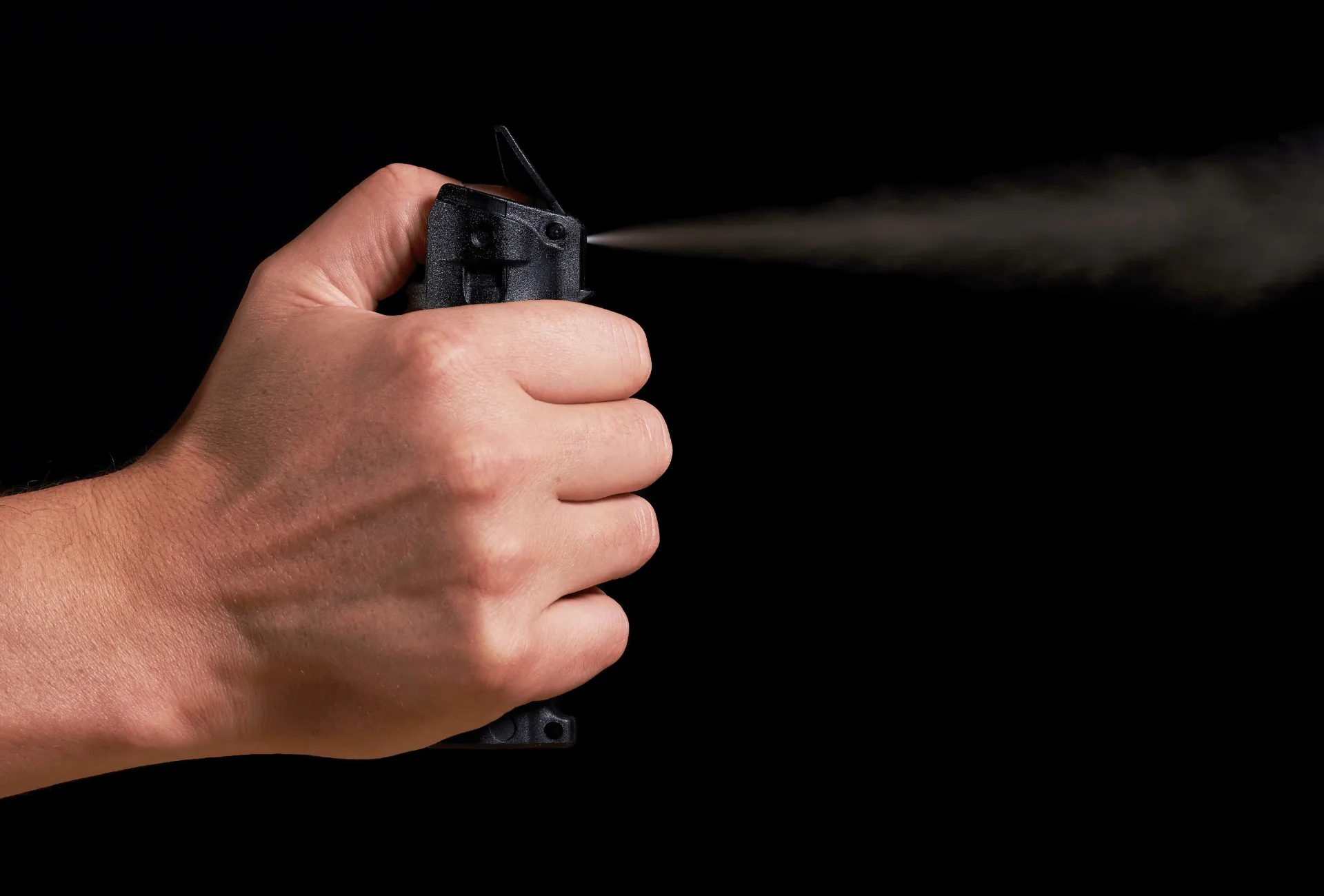We all hope to avoid a dog attack, but it’s best to be prepared in case of emergency. Knowing how to handle the situation is critical in being able to stay safe.
We’ve put together a collection of items that can fend off an aggressive dog, as well as compiled the best information on how to stay safe during a dog attack.
Even though we hope you never have to use this information, knowing how to react and what to do can mean the difference between minor or severe injuries.
The majority of dog attacks happen because of dogs that people know, rather than a loose dog on the street.
What To Do When a Dog Attacks You
The number one thing to remember if you find yourself being attacked by a dog is to stay calm. If you panic, you’ll be unable to execute a plan to keep yourself safe.
Staying calm will not only prevent you from accidentally escalating an aggressive dog into an attack, but will also help you think about your next steps.
Your first priority, as you’re staying calm, is to ensure you are standing tall, confidently, and moving slowly.
Dogs read body language extremely well, and you want to portray yourself as confident and secure.

Next, look for a place you can move to slowly and safely. This might be a doorway, a fence, or even a place you can climb.
Even if you can’t add a physical barrier between you and the dog yet, being on higher ground gives you an advantage.
If you have a sweatshirt, blanket, or other piece of fabric around, you can use that to cover the dog’s head.
Removing their ability to see for a moment can give you the opportunity you need to move away from the aggressor.
However, if things are already escalating to a bite, your next goal is to keep yourself from being bitten until you have an opportunity to move or someone is able to step in and provide assistance.
You’ll want to avoid the dog biting you at all costs, as dog bite injuries are not only painful and damaging, but they can incapacitate your ability to further defend yourself.
Instead, look for objects that you can use to put between the dog and yourself, such as a purse, rolled up coat, a stick, or anything else you find available.
As a dog is attempting to bite, try to make sure this object ends up in their mouth instead.
It’s even better if you manage to find a big, flat object that can prevent the dog from grabbing a hold of it and taking your shield away from you.
A board, large book, box, or piece of furniture can all be viable options that shield you while making it harder for the dog to land a bite.
Finally, if the attack is still progressing even with your best efforts in place, you’ll want to move on to simply trying to protect yourself the best you can.
Standing still and facing away from the dog, keeping your hands and abdomen out of reach, is ideal if you are able to stay on your feet.
If you’ve found yourself on the ground, you’ll want to curl yourself up into a ball, kneeling on the ground facing down if possible, and then placing your hands over the back of your neck.
While you ideally want to keep your hands safe, your head, neck, and abdomen become even more important if you’re caught up in a dog attack turned mauling and you need to remain safe until the dog leaves or help arrives.
After you are safe from the dog, it’s important to seek medical attention for any injuries you have, since dog bite wounds may become infected easily from bacteria present in their mouths.
It’s also important to report any dog that bit or was roaming aggressively, so that owners can be notified or the stray dog can be caught and the situation can be prevented in the future.
What To Do If a Dog Attacks Your Child
Even scarier than a dog attacking yourself is a dog attacking your child.
Unlike situations in which you can spray a repellent away from you towards a dog, you don’t want to risk using a citronella or pepper spray on a dog that is attacking your child.
Because of the closeness of the dog and child at that point, it’s too risky for your child too.
Instead, approach the dog and child making a lot of loud noise. Most dogs will be warned off by loud and firm commands or banging of an object such as a pot or pan.

It’s also important to teach your child to be a tree or a rock and practice defensive positions, just as in adults.
Standing tall like a tree, avoiding eye contact with the dog, is ideal for children that are able to stay on their feet.
Giving directions to the child for how to be a tree or a rock as you approach, making noise to deter the dog, can also be critical.
However, if the child is knocked over, encourage them to become a rock instead.
Curling up in the fetal position, on their knees facing the ground, protects their abdomen from dog bites.
They should also place their hands over the back of their neck in an effort to keep their head and neck safe from bites.
If sound doesn’t deter the approaching dog, your next objective is to get a barrier between the child and dog.
This may mean grabbing a board or other solid object to put between the dog and child, or tossing a blanket over the dog to disorient them long enough to grab your child.
If your child is small enough, and you’re able to find a safe place quickly, picking them up is a valid next option.
Otherwise, putting yourself between your child and the dog is the next best option, since your larger size is more likely to be a deterrent to the dog.
In other cases, if the dog attack has progressed and you are no longer able to simply warn the dog away, you will need to take a more drastic measure.
The wheelbarrow method is a great option to remove a dog and allow a child some time to get to safety.
This method involves grabbing the hind legs of the offending dog, picking them up so their back legs are in the air and front legs are on the ground, and moving them away.
It’s important to note, however, that you should only use this method if the dog is actively trying to bite your child, or if the dog is biting repeatedly.
If the dog has bitten and is holding on, you don’t want to risk pulling the dog away and causing further injury.
If a dog is biting and holding your child, and you cannot make noise that will cause the dog to let go or force an object between them, the unfortunate reality is that you may need to physically force the dog to let go.
Please note that this is an absolute last measure to use, and only in this emergency instance.
Forcing the dog to let go when they have grabbed a hold of your child and won’t let go for anything else involves lifting the dog slightly off the ground by their collar, twisting it until they let go to try and catch their breath.
Nobody likes to cause potential harm to a dog, but in an emergency situation where your child’s life may be in danger, it’s important to know about this option just in case.
Ultrasonic Dog Repeller
Several different products on the market make ultrasonic sounds, ones that dogs can hear but humans cannot.
The idea is that the high-pitched sound is more annoying to a dog’s ears, and that it’s less annoying to people than a loud air horn.
Do Ultrasonic Dog Repellers Really Work?
Unfortunately, evidence is more limited on the efficacy of ultrasonic dog repellent than you might wish.
While many companies claim their ultrasonic dog repellers work miracles to keep you safe, they are often not required to prove those claims.
In addition, because ultrasonic dog repellers emit sounds at a level that humans cannot hear, it can be difficult to know if the device is working when in use.
However, there are reputable products that have been tested and reviewed to be effective in stopping an approaching dog, which we will cover later in this article.
These products work by emitting a sound that is between 25,000-30,000Hz, at 100+ decibels.
This creates a loud, high-pitched sound that is inaudible to most human ears, but that can be heard by dogs.
As a dog is approaching, this sound can startle them or annoy them into leaving you alone.
Those who argue that ultrasonic dog repellents aren’t useful state that oftentimes, dogs may already be hearing plenty of ultrasonic sounds in their environment that we don’t know about.
In studies on ultrasonic sounds and animals, all of them that were bothered by the sound at first, got used to it and it no longer worked as a repellent.

Is Ultrasonic Sound Harmful to Dogs?
The sound itself is not harmful to dogs. While ultrasonic sound may seem like something out of a science fiction movie, it’s simply a designated range of sound that cannot be heard by most human ears.
However, dogs have much better hearing than humans, which is why an ultrasonic repellent device may work to stop an approaching dog.
The sound is annoying, or concerning, but it isn’t painful or damaging.
This also makes ultrasonic sound repellents a great, humane choice to defend yourself against an approaching dog without causing them harm.
What is the Best Ultrasonic Dog Repeller?
When looking for an ultrasonic dog repeller, it’s important to find one that you can verify was tested fully and has plenty of reviews showing the product works.
The Dog Dazer II is one of the top rated ultrasonic dog repellers on the market.
It’s been proven effective in many cases, and it’s small, easy to carry, and durable.
The problems with the Dog Dazer II are the same as with any ultrasonic dog repellent device. They only work in close range (15-20 feet) and they only work with a clear path to the dog.
Ultrasonic sound dissipates easily, so unfortunately, it’s not reliable at long distances or in a crowded situation.
Aggressive Dog Repellent Spray
Besides ultrasonic dog repellent devices, there are several other types of sprays that you can carry in case you need to fend off an attacking dog.
One of the products most recommended by dog professionals is SprayShield, a citronella spray that is designed specifically for the purpose of warding off an approaching dog.
Unlike pepper spray, which may come with potent side effects that last much longer than the moment of the attack, the citronella spray has proven to be effective without causing long term damage.
The downside to the citronella based sprays, as most sprays, is that they can only be used at close range and have limited capacity.
The average SprayShield bottle contains only enough spray to last 12 seconds, and sprays up to 10 feet.
The company states that it can be used 12 times, in 1 second bursts, but it’s important to keep in mind that you might be tempted to hold down the spray in a scary situation.
Will Pepper Spray Stop a Dog Attack?
As with the citronella based sprays, pepper spray can be a useful deterrent for dog attacks.
However, pepper spray comes with longer-lasting side effects in dogs, as it does in people.
Because pepper spray is also a risk to people and the handler, it should only be used if you are confident that you are spraying in the direction of the dog, and there is no wind to blow the spray back towards you.
The last thing you want to do is incapacitate yourself when trying to stop a dog attack.
Fortunately, there are pepper sprays available that are designed specifically for dogs.
Rather than a 10% solution, these pepper sprays are often only a 1% solution, due to the higher sensitivity of a dog’s nose.
These pepper sprays will be just as effective on dogs, while keeping the dog safer and allowing for a faster recovery once you are safe.
They’re also less risky to use because you aren’t as likely to be affected by them as the dog.
While using pepper spray is a viable option, we recommend planning for and using a citronella based or ultrasonic spray instead as a first line of defense, since they will be less damaging to the dog.

Best Weapon to Defend Against Dog Attack
Your best weapon to defend against a dog attack, other than a product such as SprayShield, is you.
Knowing how to handle yourself and the situation will make a much bigger difference than anything else.
It’s important to keep in mind that most of the time, a dog attack is not a dog mauling.
Cases where a dog mauls someone severely, causing intensive damage and even death, are rare in comparison.
Rather, most dogs are going to approach with aggressive intent, to warn you away, and a subset of those dogs may escalate into a single bite or two.
However, the ultimate goal would be to avoid dog bites altogether, which is where knowing how to handle yourself in the situation comes into play.
Approaching dogs are often warned away simply by a loud, stern voice. You should always avoid screaming, or yelling in a high-pitched tone, as that can instigate a dog attack.
Instead, a loud and firm “go home” can be enough to stop a dog from continuing their approach.
In addition, if an owner is present, or someone that may be able to help you is around, you can loudly, but calmly and firmly, ask them to leash their dog or to look for help.
Moving calmly and slowly is also incredibly important. Quickening your pace or running is likely to trigger a dog to bite.
While facing the dog, so you can gauge their body language and know what steps to take next, calmly and slowly walk away or to safety.
This may include moving into a car, behind a door, or even calmly climbing up onto a higher surface.
It’s also important to keep the dog in your periphery, without staring directly at the dog.
You need to be aware of what the dog is doing without staring directly, as that can be interpreted as a threat.
In addition to moving calmly, confidently, and slowly, knowing how to read dog body language will help you fend off an impending dog attack.
Rather than being unsure of the dog’s behavior, you’ll be able to have a better idea of what they are saying with their body movements.
